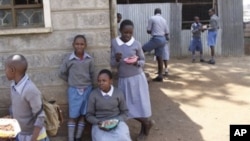Kenya will be getting new support to prevent and treat HIV/AIDS among young women. United States President Barack Obama announced last week that Kenya would be included in the DREAMS project. The U.S., the Nike Foundation and the Bill and Melinda Gates Foundation have provided money for the effort.
Girls and young women are hard hit by HIV. HIV is the virus that leads to the development of the disease AIDS. It is estimated that 7,000 young women die every year from the disease. Seventy-four percent of new infections are among young women.
DREAMS is a project aimed at reducing HIV infections among this group. The $210 million project is under PEPFAR, the President’s Emergency Plan for AIDS Relief.
Dr. Deborah Birx is the U.S. Global AIDS Coordinator. She oversees PEPFAR.
“DREAMS is a very exciting new program for us where the D stands for determine, the R for resilient, the E for empowered the A for AIDS-free and the M for mentored and the S for safe. And that acronym – that combination of items – we think is really going to be key to keep young women HIV-free.”
Dr. Birx says the rate of new HIV infections in Africa south of the Sahara Desert has fallen over the last 10 years. She says this is because of efforts by individual countries, PEPFAR and the Global Fund to fight AIDS, TB and Malaria. But, she says, the changing demographics of Africa’s population are having an effect on the epidemic – the spread of the disease.
“Africa also has this exciting, expanding young adult [population]. There are 30 percent more young adults now than at the beginning of the HIV/AIDS epidemic.”
Dr. Birx says there might be many more young adults at risk of HIV. And young women are most at risk.
She says young women in general are up to 10 times more likely to become HIV infected than young men of the same age group. So, the program aims to meet the needs of young women where they are in communities to deal with issues that lead to higher HIV risk.
The program also aims to make sure that they grow up as part of the promise to an AIDS-free generation.
Kenya will receive $30 million in additional HIV funding from the DREAMS project. Programs are already in place, so they are expected to begin soon.
Dr. Birx attended the International AIDS Society Conference on Pathogenesis, Prevention and Treatment last week in Vancouver, Canada. She says studies presented at the conference provided more evidence that the sooner HIV-infected people receive antiretroviral drugs, the better off they are.
“If patients start on treatment early, they can have this almost similar lifespan to someone who is HIV negative.”
She says that is what has happened over the last 10 years in sub-Saharan Africa. However, Dr. Birx added that PEPFAR has to do a better job on decreasing the number of new infections. Preventing new infections among young adults is cheaper than treating them once they are infected.
Two of the biggest barriers to helping girls and young women living with HIV are stigma and discrimination. Dr. Birx says across the world, PEPFAR has made the least progress in these two areas. The situation has lowered the abilities of individuals and communities to protect themselves from HIV because people are hiding their HIV status.
She says there is still a strong stigma associated with the infection at the community level. So people living with HIV/AIDS around the world are still forced into the shadows of their community.
As a result, fewer people are coming forward to be tested. People are hiding their antiretroviral pills so friends and family will not learn their HIV status.
Dr. Birx also says it is important for women to become educated and to have ways to protect themselves from violence. PEPFAR studied gender, or sex-based, violence in 10 African countries over the last five years. The information, she says, makes it clear that young women have a much higher risk of getting HIV through gender-based violence. They also face risk through other behaviors that take place after gender-based violence.
Dr. Birx says young women must protect themselves. But she also says communities have to “wrap their arms around young women and value them – and protect them from the perpetrators of gender-based violence.”
I’m Jim Tedder.
Joe De Capua reported for VOA News. Triwik Kurniasari adapted it for Learning English. Mario Ritter was the editor.
______________________________________________________________
Words in This Story
determined – adj. hopeful
resilient – adj. able to be strong
empowered – v. to give power
mentored – v. to give advice or guidance
demographics –n. the qualities of a group of people such as age, sex, number, and race
lifespan – n. the amount of time that a person lives
stigma – n. a set of negative and often unfair beliefs a society has about something
wrap – v. to put something (arms, etc.) around someone or something
perpetrators – n. people who do something that is wrong








